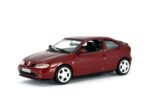Odrębne wersje popularnych modeli, mające z założenia być bardziej ekskluzywne, bardziej „premium”, to nie wymysł współczesnych marketingowców. Takie zabiegi stosowano już kilkadziesiąt lat temu. Przykładem jest Renault Ondine.
Przedstawione w 1961 roku Ondine to po prostu Renault Dauphine dla bardziej wymagających klientów. Opis Dauphine pominę – auto było szeroko opisane tutaj. Dzisiaj skupimy się na Ondine. Podobnie do modelu, na którym bazuje, producent użył nazwy z wodnymi konotacjami. Tym razem jednak, zamiast zwierzęcia, wykorzystano postać z mitologii nordyckiej – Ondynę. Ondyny, według wierzeń, zamieszkują jeziora i rzeki. Nazwa bardzo ładna – przyznacie, lecz do samochodu pasuje średnio. Bo auto ani nie miało związku z wodą, ani nie było tak ekskluzywny jakby sugerowała jego nazwa. To, pomimo lepszego wyposażenia, wciąż był mały, prosty i niedrogi sedan.
Czym Ondine różniła się od Dauphine? Kierownicą z kabrioletu Floride, matowoczarną deską rozdzielczą, grubszymi dywanikami, odchylanymi oparciami przednich foteli oraz…spryskiwaczem przedniej szyby. Od luksusów aż kręci się w głowie. Z zewnątrz wyróżnikiem były z kolei metalizowane lakiery i podwójne, chromowane zderzaki.
Jeśli chodzi o silnik, to było tutaj to samo, co w zwykłym Dauphine, czyli 4-cylindrowy silnik o pojemności 845 ccm rozwijający 27 KM. Różnicą była montowana standardowo 4-stopniowa skrzynia biegów. Dla fanów szybszej jazdy dostępna była wersja Gordini z 1-litrowym silnikiem.
Sprzedaż Renault Ondine zakończono już po dwóch latach, w 1963 roku. Ilość wyprodukowanych egzemplarzy nie jest znana.
O miniaturze
Modelik pochodzi z serii “Les Classiques de l’Automobile” wydawanej przez francuski tygodnik Auto Plus. Ondine ukazało się w lutym 2010 roku. Poziom wykonania jest typowy dla zachodnich serii gazetowych – czyli zupełnie przyzwoity. Powłoka lakiernicza jest czysta i równo położna, a oznaczenia modelu i głębia wlotów powietrza poprawiają estetykę modelu. Nawet brak fototrawionych wycieraczek nie jest szczególnie problematyczny – te, które są, wyglądają dobrze. To, czemu modelowi najbardziej brakowało, to barwione wnętrze. Dodałem je we własnym zakresie. Według mnie, różnica jest zauważalna.
*********
Separate versions of popular models, which in principle are more upmarket, more premium are not an invention of modern marketing specialists. Such measures were used for decades. The Renault Ondine is one such example.
The Ondine, presented in 1961, is really just a Renault Dauphine for the more demanding customers. I’ll spare you the description of the Dauphine – that was covered extensively here. Today, the focus is on the Ondine. Similarly to the model it’s based on, the manufacturer opted for a water-themed name. This time however, instead of an animal, a character from the Nordic mythology was used – the Ondine. Ondines, according to the mythology, lived in lakes and rivers. You must admit – a very pretty name, but it doesn’t really fit the car. The car had nothing to do with water nor was it as upmarket as its name would suggest. It still was, despite slightly better equipment, a small, simple and cheap saloon.
How was the Ondine different from the Dauphine? It had a steering wheel from the Floride convertible, a matte-black dashboard, thicker carpets, reclining front seats and… a windscreen washer. All the luxuries that make your head spin! Outside, a choice of metallic paints and double chrome bumpers set the model apart.
When it comes to the engine, it was no different from the Dauphine. This means a 4-cylinder, 27hp, 845 cc unit. What made a difference was a 4-speed gearbox fitted as standard. For the fans of faster driving, a 1-litre Gordini variant was also available.
Sales of the Renault Ondine ended after 2 years already, in 1963. The number of units produced is unknown.
About the miniature
The model comes from the “Les Classiques de l’Automobile” partwork series, published by a French magazine Auto Plus. The Ondine was released in February 2010. The model’s quality is typical of Western partwork series, meaning it’s rather decent. Paintwork is clean and even, while the model’s emblem and air vents improve its aesthetics. Even the lack of photoetched windscreen wipers isn’t particularly problematic – the ones that are fitted look good. What the model was lacking however, was a coloured interior. I did this myself and I think the difference is visible.
















